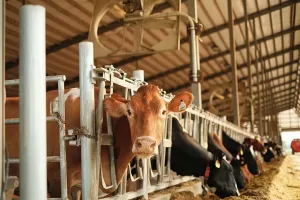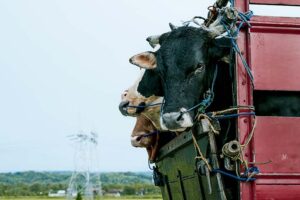By David Steel, president of Earthsave Canada
Meat is terrible stuff. Behind it lies horrible suffering, environmental degradation and even damage to our health.
The vast majority of animals raised for meat, eggs and dairy are raised on so-called Concentrated Animal Feeding Operations (CAFOs), a.k.a. “factory farms.” As undercover video after undercover video has shown, these are truly horrific places. Chickens live six or eight to a cage with less than a sheet of paper’s ‘floor’ space to each of them; mother pigs live in cages so tiny that they can’t even turn around. Debeaking, tail docking, castration, even tooth cutting are all standard practice – without anesthetic.
Animal agriculture’s environmental effects are similarly terrible. Livestock farming, the EPA estimates, is responsible for 50-85% of ammonia pollution in the US. The UN Food and Agriculture Organization pegs animal agriculture as responsible for nearly a fifth of all greenhouse gas emissions. Raising livestock and the soybeans to feed them is easily the biggest contributor to rainforest destruction. And, as Cornell University’s David Pimentel calculates, the way we raise meat, it takes some 28 calories of fossil fuel to generate one calorie of food value.
Directly relevant to human health, the common practice of feeding antibiotics to farm animals – the FDA reports that more than 80% of antibiotics in the United States are fed to them – has generated “super bugs” so dangerous that the head of the World Health Organization declared earlier this year that the era of safe medicine is ending. “A post-antibiotic era,” she said, “means, in effect, an end to modern medicine as we know it. Things as common as strep throat or a child’s scratched knee could once again kill.” And, of course, recent studies show that eating red and processed meats dramatically increase cancer risks.
Surely, this can’t go on. More and more of us are aware that we need alternatives. And fast.
So, it’s no surprise that many are pleased by the prospect of growing meat without animals. Vascular biologist Mark Post, at the University of Maastricht in the Netherlands, claims he’ll be able to make a hamburger that way within the next year. No killing, it seems. Much reduced pollution.
At first blush, this in vitro meat sure sounds promising. As described, it would require far less land; there would be no need to grow enormous tracts of corn and soy for animal feed. There’d be no manure to worry about. And there’d be a great deal less cruelty.
An in depth analysis published last year in the scientific journal Environmental Science & Technology (Tuomisto and Teixeira de Mattos, Env Sci Technol 45(14):6117-23, 2011 http://pubs.acs.org/doi/abs/10.1021/es200130u) indicates that in vitro meat would require 99% less land, 82-96% less water, even 7-45% less energy than meat produced from animals raised in Europe. Unfortunately, the study is deeply flawed. Its estimates are based on highly questionable assumptions: i.e., that the meat would be raised as free cells in unheated vats, that 80% of the water used to grow the cells would be recycled without treatment, and that the cells would be fed entirely with cyanobacteria. None of these assumptions are even close to realistic.
There is essentially no chance that meat can be grown like that. Instead, a complex mix of nutrients, growth factors and hormones will be required, very likely in large measure derived from animals and their blood. The mixture will have to be heated to a constant 98 or 100 degrees Fahrenheit (37-38 degrees Celsius); oxygen will have to be delivered, waste products constantly removed. Reusing even 1% of the water without treatment is extremely unlikely.
Growing something that approximates the beef or pork or chicken that people expect will be a daunting task. The meat that Mark Post is producing in the Netherlands is grown in blood serum from fetal calves. It is only 100-200 micrometers (1/250th to 1/125th of an inch) thick and roughly an inch long. It is nothing like what most people would call meat.
To produce meat that looks and feels like meat will require growing the cells on some sort of internal scaffold with an artificial vascular system filled with either hemoglobin (from blood) or a chemical oxygen carrier. For obvious reasons, it is hard to see how blood could be used. On the industrial scales envisioned, enormous amounts would be required. If the chemicals are used, they’ll have to be somehow removed from the meat before it is sold. In either case, system to remove waste products as the meat grows will be essential.
Also, because there is no immune system in cell culture, large amounts of antibiotics and antifungal drugs will be needed to keep the growing meat from being over run with germs. The possibility of viral infections will be high.
All in all, this seems insane. It is true that animal agriculture needs to go. But it does not make sense to attempt to replace it with an enormously high tech system that, if it does work, is likely to be extremely expensive and may still require major inputs of blood and the like. There is little chance, even, that a venture like this will ever be economically viable.
And there’s no need. If one feels the need for something that tastes like meat, there are already plenty of plant-based alternatives available. Field Roast, Gardein, Tofurky, Yves. NY Times food critic Mark Bittman was recently fooled in a blind taste test comparing chicken with Savage River Farms’ soy-based substitute. Stanford University biochemist Patrick Brown reportedly has developed meat substitutes that are similarly hard to tell from the “real thing.”
So, what’s stopping you? If you feel you must eat meat, do the responsible thing. Eat the plant-based stuff. Don’t wait for a pie in the sky scary high tech solution to come around.
By David Steel, president of Earthsave Canada







